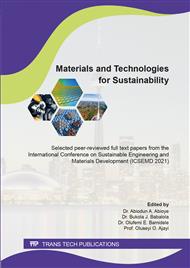p.3
p.10
p.22
p.32
p.41
p.54
p.63
p.73
Development of Biodegradable Plastic Sheet from Blends of Low Density Polyethylene (LDPE) and Banana Peel Starch
Abstract:
The application of short-term packaging plastics that are biodegradable and possess the same or even greater mechanical properties as regular synthetic plastics is on the rise. These plastics, when disposed, are acted upon by microorganisms that are present naturally in soil and primarily release water and carbon dioxide into the atmosphere. In this study bioplastics was created using banana peel starch and LDPE coupled with plasticizers such as palm oil and glycerol, mechanical properties of the newly created bioplastic were studied. Furthermore, the characterization of the starch particles derived from renewable source were carried out using EDX and SEM. The biodegradation studies using glycerol as a plasticizer showed that 95%-LDPE breakdown occurred by 4.27% after 7 days, 17.7% after 14 days, and finally 25.77% after 28 days. However, when Palm Oil was used as a plasticizer, 95% -LDPE degradation occurred at 1.16% after 7 days, 2.57% after 14 days, and 5.15% after 28 days. This indicated that glycerol-plasticized LDPE-Starch sheets degraded at a quicker pace than palm oil-plasticized LDPE-Starch sheets. Finally, this study revealed that glycerol-plasticized LDPE-Starch sheets have better physiochemical properties (compressive and tensile stress) than palm oil-plasticized LDPE-Starch sheets. Keywords: Biodegradable; Plastic Sheet; Polyethylene (LDPE); Banana; Starch;
Info:
Periodical:
Pages:
22-31
Citation:
Online since:
April 2022
Keywords:
Price:
Сopyright:
© 2022 Trans Tech Publications Ltd. All Rights Reserved
Share:
Citation:


